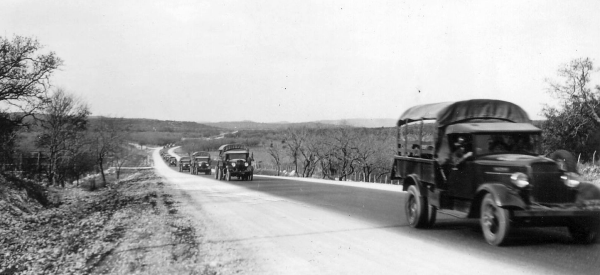
Military convoy between San Antonio and Camp Bullis ca. 1935
This is on today's I‑10 at UTSA Blvd. looking north.
(Photo courtesy of TxDOT)
No compendium of road history in San Antonio would be complete without a discussion of the military. Given the armed forces' key role in the area's economy, as well as strategic considerations, military mobility has played an integral part in the area's road development going all the way back the Spanish Colonial era.
Military Road
The first instance of this in modern history came in the 1930s when the need for a more direct route from Kelly Field to Brooks Field emerged. To satisfy that, the county built the Military Road (later Military Drive) to connect the two. This was essentially the first section of a loop proposed in the 1932 Arneson Plan for state highways in Bexar County, albeit a bit further north than that plan had envisioned. Arneson's plan had noted the need to separate military and civilian traffic, so he proposed a loop to connect the area's installations to divert military traffic around the city, but also warned that special care would be needed in planning the route so as to not disrupt the bases.
First bits of a loop
In 1937, the state acquired and began improving Military Road — including an overpass over Quintana Rd. and the adjacent railroad — and designated it as the first segment of Loop 13. Around 1943, Loop 13 was extended west from Pearsall Rd. through the new San Antonio Aviation Cadet Center (later renamed Lackland AFB) to US 90, and east from Brooks Field to WW White Rd. Around 1946, Loop 13 was extended north along WW White to US 90 East. WW White continued north of there as a county road along today's Springfield Road to the Seguin Road (today's FM 78), which connected the eastern end of Fort Sam Houston to Randolph Field, thus providing more-or-less direct connectivity between the five installations. Seguin Road was sometimes called "Randolph Field Road" because of its connection to that installation.
Access to Randolph
Before the mid '30s, Seguin Road (most of which is today's FM 78) was SH 3, the main highway between San Antonio and Houston, and therefore provided a direct major state highway connection right at Randolph's main gate. However, in the mid '30s, the state built a new route for SH 3 several miles to the south of Randolph (that route is today's I‑10). Although the Arneson Plan had also proposed a new, straighter route from Randolph to the new SH 3, it seems the state nixed that idea at some point in favor of a new road to connect the installation with nearby US 81/SH 2 (today's I‑35.) Built in 1935, that route is today's SH 218/Pat Booker Rd., which, along with US 81, provided a new high-speed link to Fort Sam Houston. It was named for Francis Pascal "Pat" Booker, an Army Air Corps captain who died in a crash in September 1936. In the 1950s, the state studied an overpass for Pat Booker Rd. over FM 78 and the adjacent railroad and into Randolph, but for reasons unknown, it never came to fruition. (
Special thanks to Michael P. Hoffman for some of the history of Pat Booker Road.)
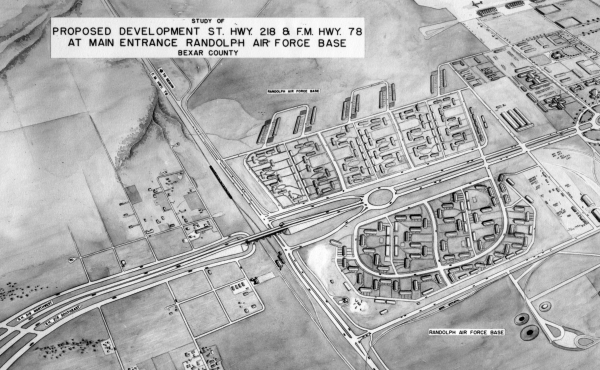
Proposed overpass at Randolph main entrance ca. 1955
(Document courtesy of TxDOT)
Harry Wurzbach
The United States' entry into WWII created a new urgency for improving roads serving the local military installations. To that end, the "Harry Wurzbach Military Highway" (at that time sometimes referred to simply as "Military Highway") was built by the county, state, and Works Progress Administration around 1943 to directly connect Fort Sam Houston to Camp Bullis, which was known as Leon Springs Military Reservation at the time. Its purpose was to replace a circuitous route through the city from Fort Sam to Camp Bullis via US 87/Fredericksburg Rd. The new road encompassed what's now Harry Wurzbach Rd., NW Military Hwy., and the stretch of today's Loop 410 in between, part of which at the time was a road named Zercher Rd. This linkage is why Harry Wurzbach and NW Military bend toward each other at Loop 410. The route included overpasses where it intersected US 81 (Austin Hwy.) and US 281 (San Pedro Ave.) to safely separate the military and civilian traffic streams.
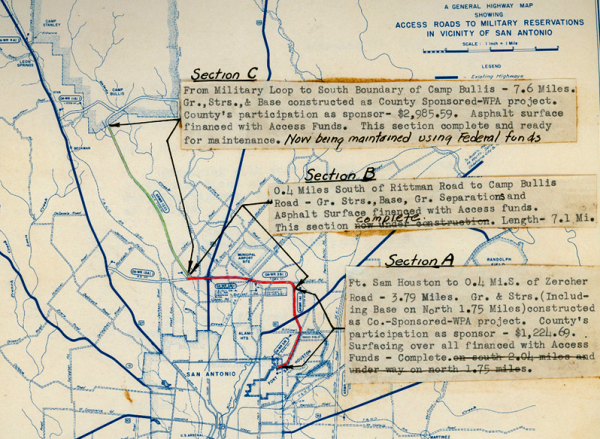
Map showing status of Harry Wurzbach Military Highway construction in 1943
Also note the early proposal for Loop 410 (referred to as "Military Loop" in the notes) west of
NW Military — it would have connected to US 87 (Fredericksburg Road) just north of Wurzbach Rd.
(Source: Texas State Library and Archives)
War Highways
Also around 1943, present-day Camp Bullis Rd. between today's I‑10 and Camp Bullis was built by the county in cooperation with the Highway Department to replace the existing narrow and winding road connecting the installation to US 87. The road was designated "War Highway 2", one of 21 such routes around the state built to support the war effort. Those designations were dropped six months after the war ended.
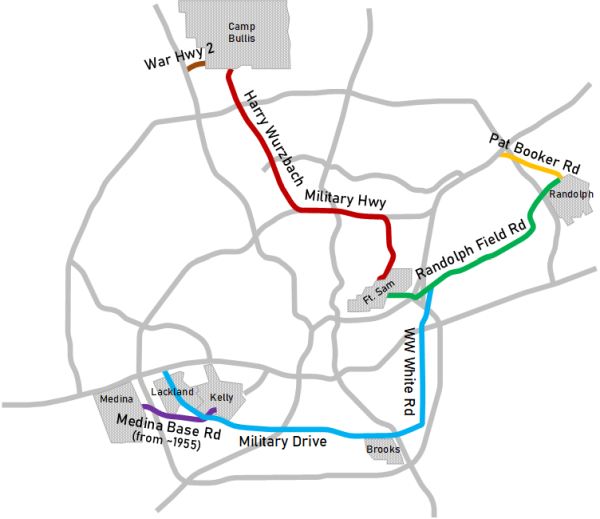
Map of the various military roads in San Antonio around 1945 overlaid on today's freeway network
Loop 13 grows
Around 1950, a new segment of Loop 13 was established along today's Loop 410 from Austin Hwy. westward to San Pedro Ave. (then US 281), subsuming part of the Harry Wurzbach Military Hwy. Around 1953, Loop 13 on the East Side was extended north from US 90 by straightening WW White Rd. and constructing an overpass over FM 78 and the railroad tracks, then continuing further north along present-day Loop 410 and I‑35 to meet US 81 (today's Randolph Blvd. and Austin Hwy.) near the community of Fratt. This connected it with the section of Loop 13 headed west. During the war, there had been a short-lived proposal for this northeastern section of the loop to head more northwesterly from its crossing at FM 78 to cross Rittiman Rd. at Salado Creek, then follow Salado Creek to Austin Hwy., and then veer northwest to meet Harry Wurzbach near today's Loop 410. It was thought this would better facilitate military traffic, but it was ultimately nixed since the state had already invested substantially in the route north to Fratt, and because the increase in access it would provide for the military was determined to be marginal.
Military Drive West
While it seems like it may have been a logical extension of Loop 13 northward, Military Drive north of US 90 was actually not part of any plans for the loop. Instead, the original plan was to use Callaghan Rd. coming from the north, and continue south from US 90 between Kelly and Lackland to meet the existing Loop 13 on the South Side. Those plans changed when it was determined that Military Dr./Loop 13 on the South Side had become too urbanized for easy expansion, so a new route for what would become Loop 410 on the South Side was plotted further south along Chavaneaux Rd. and west of Lackland along Dwyer Rd., and then extended north and northeast from there. The first section of Military Drive West north of US 90 was built in 1961 to instead mainly serve new residential areas sprouting up north of Lackland. Over the years, it has been extended further north and west with an underpass for it at Loop 410 built in 1982. Coincidentally, it now runs past the San Antonio campus of the National Security Agency, providing yet another military context for the road. County officials did ask the Texas Transportation Commission in 1968 to extend Loop 13 from US 90 to Potranco Rd., but the request was apparently denied.
Medina Base Road
Just like with Fort Sam and Camp Bullis, a need arose to connect Kelly Field and Medina Base, probably to provide a direct route to transfer atomic weapons stored at Medina to and from the airfield at Kelly. So in the mid '50s, the Medina Base Road was built. However, instead of intersecting Old Pearsall Rd. as it does today, it originally turned northeastward just west of Old Pearsall Rd., crossed Military Dr. and Leon Creek, and intersected with Westover Rd. on the west side of the airfield. While that section of the road is long gone now, the bridge at Leon Creek is still there today. The rest of the route to the west was essentially the same as it is today. When Loop 410 in that area was built around 1960, it didn't include an interchange with Medina Base Road, perhaps to limit traffic on the road in order to avoid conflicts with the military traffic. An interchange was subsequently built in the late '60s after the weapons center at Medina was transferred to another facility near Amarillo.
Just passing through
Local military installations have also played a role in other local road history. The first state highway to the northeast (SH 2 to New Braunfels, Austin, and beyond) crossed through Ft. Sam Houston, which was an open post until 2001. Heading north along N New Braunfels Ave., it passed through Ft. Sam, then turned east onto Eleanor St. and followed Old Austin Rd. along the edge of the post, then crossed through Ft. Sam again near the old BAMC and onto today's Harry Wurzbach before continuing northeast onto Corinne Dr., Austin Hwy., and Randolph Blvd. SH 2 continued to pass through Fort Sam until the late '20s when the route was changed to use Broadway and Garraty Rd. instead. It's unclear if that change was made to avoid traversing the post or if it was to reduce the complexity of the downtown end of the route; perhaps it was a bit of both.
Before the current runway was built at Kelly Field during World War II, Frio City Rd. connected to today's Old Pearsall Rd. at SW Military Dr. (looking at a map, you can see how they line up) and was also part of SH 2, which to the south was the route from San Antonio to (you guessed it) Pearsall and on to Laredo. Part of that road is now the section of General Hudnell Dr. in Port San Antonio. When Kelly Field was first established at the height of World War I in 1917, it occupied the wedge of land between that road and the railroad tracks along Quintana. A second military field, unimaginatively called Kelly Field #2, was built almost immediately thereafter in the area immediately northwest of the original site, with SH 2 then dividing the two. New Laredo Highway was then built in the late '30s per the Arenson Plan to replace the route through Kelly. During WW II, the two airfields, then known as Kelly Field and Duncan Field, were combined and expanded, and the remaining road through the consolidated Kelly Field was truncated in order to build new runways and hangars.
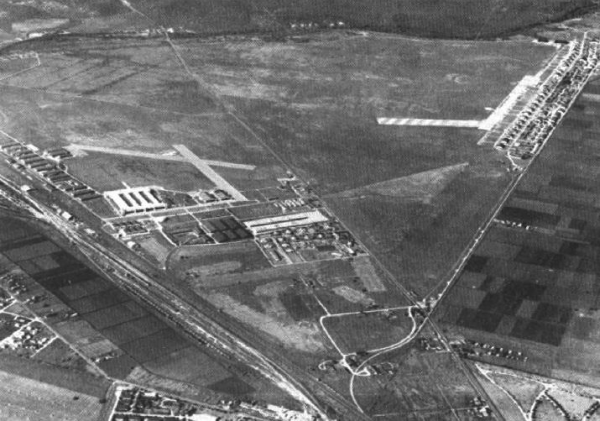
Duncan (left) and Kelly (right) Fields 1935
This view is looking to the southwest; Leon Creek is at the top.
The road in the middle of the two air fields is the old SH 2.
(Source: United States Air Force via
Wikipedia)
Which Military?
San Antonio is known for having an unusual number of street naming idiosyncrasies that confound locals and visitors alike. One of those is that there are three distinct roadways with "Military" in their name: SE/SW Military Drive, Military Drive West, and NW Military Highway. Here is the breakdown of each:
- SE/SW Military Drive: This roadway, also designated as Loop 13, is the main "drag" of the South Side of San Antonio running from S WW White Road near Loop 410 westward crossing both I‑37 and I‑35. It becomes Military Drive West (see next bullet) somewhere near Whitewood St. just west of Pearsall Rd. S Flores St. is the dividing line between SW and SE Military Dr.
- Military Drive West: Military Drive West, also sometimes called W Military Dr., continues north from the end of SW Military. If you're not paying attention to the signs, you won't even notice the name change. It runs through the middle of Lackland AFB before crossing US 90 (where the Loop 13 designation ends), SH 151, and Loop 410. For over three decades, it ended at Potranco Rd. In the mid '80s, another leg of Military Drive West sprung up further west between SH 151 and Grossenbacher Rd, gradually creeping eastward and southeastward toward Potranco. The gap was finally closed in 2020.
- NW Military Highway: This is a completely separate roadway from the others that runs from Loop 410 through Castle Hills to Camp Bullis. Although it has the word "Highway" in its name, it's actually just a regular arterial roadway and is also designated FM 1535.
Coincidentally, Harry Wurzbach Rd. is another example of the local phenomenon of multiple roads with similar names: the three roads named Wurzbach. For more information on that and on the history of the Harry Wurzbach name, see the Which Wurzbach? page.







